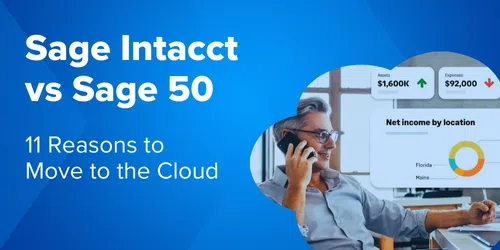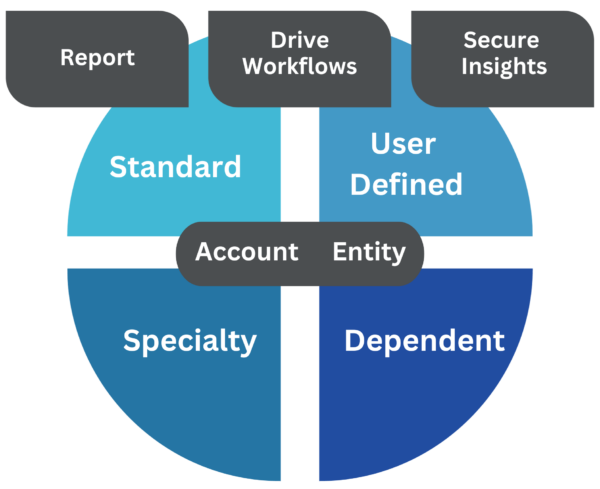Sage Intacct vs Sage 50: 11 Reasons to Move to the Cloud

As your business grows and evolves, your needs change, especially when it comes to accounting software. Maybe you’ve added locations, manual processes are slowing down your operations — or you lack insight into cash flow. Many small- to mid-sized businesses start out using Sage 50, an excellent entry-level accounting software. However, as your business expands, its financial management needs become more complex, and the limitations of Sage 50 become apparent.
if you’re outgrowing Sage 50 consider transitioning to Sage Intacct. A cloud-based financial management solution endorsed by the AICPA, Sage Intacct offers scalability and robust features. This comparison of Sage Intacct versus Sage 50 presents 11 compelling reasons why upgrading to Sage Intacct could transform your business operations.
1. Enhanced Scalability
Sage 50 accounting software is well-suited for small and medium-sized businesses, and many rely on it to effectively address their accounting needs. However, Sage 50 capabilities may not keep pace as your business grows. Sage Intacct native cloud solution offers advanced scalability and is designed to handle increased transaction volumes and more complex accounting requirements without compromising performance. Additionally, as a SaaS solution Sage Intacct continuously receives real-time updates, enabling users to take advantage of the latest features, contrasting significantly with legacy platforms like Sage 50 that offer limited upgrades.
2. Superior Cloud Accounting Capabilities
Sage Intacct is a true cloud-based system, unlike Sage 50, which primarily offers desktop solutions with limited cloud functionality. Sage 50 is known for its reliable desktop accounting solutions, making it a trusted choice for small businesses over the years. However, as a native cloud solution, with Sage Intacct you can access your financial data anytime, anywhere, from any device with internet access. This level of accessibility is crucial for businesses with remote teams or those needing real-time data access.
3. Advanced Customization and Integration
Sage Intacct excels as a software solution with robust customization and integration capabilities. It allows seamless integration with other business-critical solutions (CRM, HRMS, AP and AR Automation, etc.) to build automated data flows and reduce error prone processes like manual data entry. Unlike Sage 50, Sage Intacct’s customization and configuration capabilities ensure the software fits your business processes, not the other way around.
4. Comprehensive Real-Time Advanced Financial Reporting
Real-time advanced financial reporting is one of Sage Intacct’s standout features. Many Sage 50 users rely on an extensive collection of spreadsheets, manually compiling the reports they need into financial statements. In contrast, Sage Intacct provides real-time insights into financial performance with customizable dashboard capabilities and reports. It’s an ideal way to give your stakeholders access to real-time decision-making data and visibility into key metrics, which is not possible in Sage 50.
5. Dimensional Chart of Accounts
One of the transformative features of Sage Intacct is its dimensional chart of accounts. This feature allows your business to tag transactions with dimensions such as location, department, project, or any other meaningful identifier rather than relying on a rigid, traditional account number structure. Dimensions support more dynamic reporting and deeper insights into your financial data. With dimensions, for example, you can easily analyze financials across various business perspectives without managing a bloated general ledger with hundreds (or even thousands) of accounts.

5. Multi-Entity Management
For businesses managing multiple entities, Sage Intacct offers a comprehensive multi entity management solution that simplifies inter-entity transactions, consolidations, and reporting. This is in stark contrast to Sage 50, where managing accounting across multiple entities can be cumbersome and time-consuming.
6. Automated Complex Financial Processes
Sage Intacct automates complex financial processes, eliminating error-prone manual tasks. As a result you’ll realize efficiencies in many areas including revenue recognition, project accounting, inventory management, accounts payable, and accounts receivable. These processes can be particularly labor-intensive in Sage 50, making Sage Intacct a more efficient software solution for growing businesses with sophisticated financial structures.
7. Compliance and Financial Management Governance
Sage Intacct helps businesses comply with various accounting standards, including GAAP, IFRS, and others. It offers built-in compliance frameworks and audit trails to ensure your financial governance is maintained. Compliance is more challenging with Sage 50 due to risks like data corruption.
9. Improved Expense Management
With basic accounting features like project-based billing and expense management, Sage Intacct provides detailed control over expenses, improving visibility. This level of control is particularly beneficial for construction and service-based businesses that need to manage project costs effectively.
10. Robust Security Features
As a cloud accounting system, Sage Intacct provides robust security measures, including data encryption, redundant data backups, and strict access controls. These features are essential for protecting sensitive financial data and are much more comprehensive than in desktop-based systems like Sage 50.
11. Enhanced Collaboration
The cloud-based nature of Sage Intacct facilitates better collaboration across departments, offering all the benefits of cloud technology. For example, included in Sage Intacct is a Collaborate feature that allows you to communicate easily with your teams to help you quickly solve accounting issues.
Inform and stay informed by leaving notes on tasks and issues in Sage Intacct. With real-time data sharing and accessibility, your teams can work together more effectively, regardless of location.
Ready to Learn More About Moving from Sage 50 to Sage Intacct?
Migrating from Sage 50 to Sage Intacct represents a strategic move towards more efficient, scalable, and insightful financial management. With its superior cloud capabilities, comprehensive customization options, and powerful automation, Sage Intacct is designed to meet the needs of growing businesses. In fact, according to Gartner’s Critical Capabilities Report, Sage Intacct received the highest rating, highlighting its superior performance.
When considering Sage Intacct vs Sage 50 one area that can be a challenge is what to do with the legacy system data. Fortunately, the Sage Intacct migration process simplifies this process, saving you from unnecessary complexity. This allows you to dedicate more time to tailoring Sage Intacct to your workflows and learning your new software.
Here are just a few of the ways we streamline the migration from Sage 50 to Sage Intacct
- Help your team evaluate your data cleansing requirements. From there, lead the data mapping process to ensure a high-quality data migration.
- Translate your Sage 50 GL account balances into your Sage Intacct chart of accounts.
- Provide an automated data migration engine to populate Sage Intacct with your Sage 50 data for a faster deployment.
- Offer a library of standard financial reports in Sage Intacct and role-based dashboards enabling faster time to value.
Contact us to learn more about how migrating from Sage 50 to Sage Intacct can transform your growing business. Our experts will guide you every step of the way, ensuring a successful outcome.




